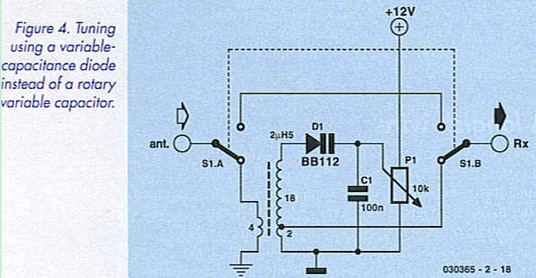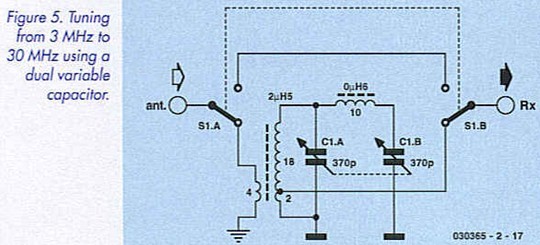

Project Solutions
Wave catcher (3)
Published:2011/7/26 0:39:00 Author:Phyllis From:SeekIC
By Burkhard Kainka
Tuneable
The standard approach to building a preselector is to use a tuneable resonant circuit (Figure 3). The coil can be wound as an air-core coil, which means without using an actual core. The wire diameter is not all that important for such air-core coils. For small coils, you can use enamelled copper wire with a diameter of 0.3 to 0.7 mm: somewhat heavier wire should be used for larger coils for the sake of mechanical stability. 
A coil having a diameter of 8 mm and 20 turns over a length of 10 mm has an inductance of 2.5 uH. In combination with a 370-pF variable capacitor, it has a lower resonant frequency of approximately 5 MHz. This circuit can thus be tuned across the 49-m band and the higher-frequency bands up to around 16 MHz. A tap at the second turn provides the proper impedance for connection to the receiver.
The aerial can be connected using a coupling coil with two to four turns. If you make the coupling coil such that it can be moved back and forth, the degree of coupling can be adjusted. You can then experimentally determine the best adjustment. Tighter coupling yields a higher signal voltage, but it decreases the Q factor of the resonant circuit and thus reduces the attenuation at the mirror frequency. If it is necessary to use a short aerial (such as a rod aerial), the coupling must be designed to be relatively tight. In this case, the aerial can be connected directly to the hot end of the resonant circuit. The resonant circuit shown in the figure has a high Q factor (typically 50). This yields a bandwidth of 120 kHz at 6 MHz. As a result, the variable capacitor must be tuned relatively precisely. For DRM reception, the optimum tuning can be recognized by a maximum signal level in the spectrum display generated by DRM software, but the delay in processing the date for this display makes adjustment difficult, it is easier lo use direct acoustic monitoring by connecting the receiver output directly to the Line In socket of the sound card. It’s then easy to tune for maximum noise volume for the DRM transmitter using the speakers of the PC.
If the preselector is built into an enclosure, the most important frequencies should be marked on a scale. Figure 4 shows the same type of resonant circuit with the rotary variable capacitor replaced by a high-value variable-capacitance diode, such as the type BB112 (available from Geist Electronic). Here it is important to use a stable. well-filtered voltage for the tuning potentiometer, since otherwise reception can be degraded by phase modulation of the aerial signal. 
The tuning range of a simple resonant circuit does not exceed 1:3 with a standard variable capacitor. One solution is to use several coils that can be selected using a rotary switch. Another approach is used by radio amateurs, who are faced with the same problem in the standard amateur radio bands (80 m to 10 m. which corresponds to 3.5-29.7 MHz). This requires a preselector with a tuning range of 1:10. The solution is to use coupled circuits with two fundamentally different resonant frequencies. Figure 5 shows a proven circuit using a dual variable capacitor and a second coil with 10 turns. Although there are two "bad" pass frequencies for every setting, they are well separated from the mirror frequency of the receiver. 
Good air-dielectric variable capacitors are no longer easy lo come by. It is often possible to scavenge them from old radios. One source of suitable multi-gang variable capacitors from current production is Gcisl Electronic (www.2eist-electr0nic.de).
Reprinted Url Of This Article: http://www.seekic.com/blog/project_solutions/2011/07/26/Wave_catcher__(3).html
Print this Page | Comments | Reading(2523)
Article Categories
New published articles
· Imagination works with TSMC to develop FinFET process
Author:Ecco Reading(45548)
· XMOS pushes event-driven MCUs with lower price
Author:Ecco Reading(4142)
· Intel brings upgraded 32-nm SoC for smartphones
Author:Ecco Reading(3865)
· Micron pushes TLC 128-Gbit NAND flash
Author:Ecco Reading(4611)
· Intel will stop supplying desktop motherboards
Author:Ecco Reading(5961)
· Processor market was expected to regain strength in 2013
Author:Ecco Reading(3957)
· It was reported that TSMC sales fall steeply
Author:Ecco Reading(3619)
· Cisco, NXP work with auto wireless startup
Author:Ecco Reading(4283)
· Micron was impacted by manufacturing glitch
Author:Ecco Reading(4647)
· China can make 22-nm transistor by themselves
Author:Ecco Reading(4485)
· Chip market rebound is coming, according to survey
Author:Ecco Reading(4386)
· Sony, Toshiba will spend more on chips, iSuppli reports
Author:Ecco Reading(3954)
· Qualcomm becomes the 13th company to join NFC Forum board
Author:Ecco Reading(6795)
· TSMC increases building work for FinFET fab
Author:Ecco Reading(4467)
· TI plans to cut 1,700 jobs in OMAP shift
Author:Ecco Reading(5327)